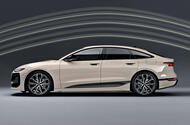Audi A6 E-tron: The Epitome of Aerodynamic Efficiency

The A6’s drag coefficient is on a par with that of the Hyundai Ioniq 6
The recently unveiled Audi A6 E-tron is not only Audi’s most aerodynamically efficient car to date, but it also stands as one of the sleekest vehicles available in the market. This exceptional aerodynamic design plays a pivotal role in achieving the A6 E-tron’s impressive range of 466 miles.
A New Era of Range-Chasing Design
With a drag coefficient of 0.21, the A6 E-tron is on par with the Hyundai Ioniq 6 and just below the Tesla Model S and Mercedes EQS. This achievement represents a significant milestone in Audi’s pursuit of aerodynamics, following the footsteps of iconic streamlined vehicles like the Auto Union Type C, NSU Ro 80, Audi A2, and Mk3 Audi 100, which was the most aerodynamically efficient car of its time. Moni Islam, Audi’s head of aerodynamic and aeroacoustic development, emphasized that vehicle electrification has sparked a renaissance in vehicle aerodynamics.
Islam explained that approximately 40% of a car’s energy is consumed in overcoming air resistance, a figure that rises to nearly 60% at higher speeds. This becomes even more crucial in electric vehicles, where a third of the battery’s energy is used to combat wind resistance. However, Islam highlighted that EVs present new opportunities to overcome this challenge.
Compared to combustion powertrains, electric powertrains have significantly higher thermal efficiency. As a result, a larger proportion of fuel in traditional vehicles is expended in heat, with only 10% of this energy utilized to overcome aerodynamic drag. This disparity underscores the importance of aerodynamics in electric vehicles. Additionally, EVs benefit from a flat floor design that is easier to optimize aerodynamically, while internal combustion engine (ICE) cars often have exposed components for cooling purposes, limiting airflow optimization.
To maximize the efficiency of the A6 E-tron and its sibling, the Q6 E-tron, Islam and his team have been involved in the development of Audi’s new PPE platform from the outset. This collaboration with designers and engineers ensures that the cars utilizing the platform achieve optimal efficiency.
Innovative Aerodynamic Features
The Audi A6 E-tron incorporates various innovative aerodynamic features that contribute to its exceptional efficiency:
Active Shutters
When the radiator does not require cooling, the front grille flaps close, redirecting air over and beneath the car. This simple adjustment adds more than seven miles to the vehicle’s range.
Air Curtain
Air channels integrated into the front wings guide airflow efficiently around sharp corners, optimizing its interaction with the wheels.
Wheels
The design of the A6’s wheels maximizes brake cooling and unblocks the flow from under the body, enhancing overall aerodynamic performance.
Virtual Mirrors
The optional side cameras, slimmer than standard mirrors, not only enhance aesthetics but also increase the vehicle’s range by approximately 4.3 miles.
Air Suspension
At speeds exceeding 75mph, the A6 E-tron lowers by 20mm, reducing turbulence inside the wheel arches and smoothing airflow over the body.
Hidden Gurneys
Precision-designed Gurney flaps at the rear of the floorpan redirect air away from the rear axle, while mini spoilers on the rear wheels create a bubble of still air, even at high speeds.
Q&A with Gernot Dollner, CEO of Audi
The most aerodynamically efficient cars are low and sleek, but your customers want SUVs. How do you approach that paradox?
Dollner acknowledges that SUVs pose a challenge in terms of efficiency but emphasizes that customer demand for SUV cars is significant. He highlights that, by the end of the decade, 85% of vehicles in the US will be trucks or SUVs. While China still favors conventional limousines and flat cars, the global trend leans towards SUVs.
How will your next-generation EVs compete with technically advanced rivals from China?
Dollner acknowledges the strong competition, particularly from the 104 new brands that have emerged in China in the last three years. However, he expresses confidence in Audi’s values, such as design quality, classical driving functions, efficiency, and range, which he believes are best in class. While Audi recognizes the need to improve in-cabin experience and automated driving, Dollner believes they are steadily catching up in these areas.
Is there a future for Audi below the A3, with the A1 and Q2 being phased out?
Dollner affirms Audi’s commitment to the A3 segment and reveals plans for an entry-level battery-electric vehicle produced in Ingolstadt, catering to the lower end of the segment.

